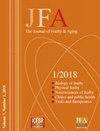致编辑的信:膳食摄入与日本社区居住的老年人虚弱的过渡。
IF 3.3
Q2 GERIATRICS & GERONTOLOGY
引用次数: 0
摘要
本文章由计算机程序翻译,如有差异,请以英文原文为准。
Letter to the Editor: Dietary Intake with the Transitions of Frailty among Japanese Community-Dwelling Older Adults.
I read, with great interest, the recent article by Rei Otsuka et al. (1). This article’s main result is the association between dairy products and frailty transition. In fact, little research focuses on this association. Thus, the influence of dairy products on frailty is still unclear (2). Although some studies found that dairy products seem to have a preventive effect on frailty among older adults, they all consider causality mainly in terms of nutrition (3, 4). It’s necessary, but two obstacles exist to exploring the association in this way. First, dairy products include nutrients beneficial for frailty prevention, such as protein and calcium. But they also include negative nutrients for frailty, like saturated fatty acid. Besides, dairy product consumption is related to different dietary patterns, which may be beneficial or adverse for frailty prevention (2). As Berna Rahi and his colleagues mentioned, all these effects may be offset interactively (2). Thus, the true association between dairy products and frailty is hard to be exposed. Second, because of the known benefits of some nutrients for many geriatric diseases, it’s difficult to attribute the improvement in frailty to dairy products. For example, in a recent study, Berna Rahi et al. adjusted for total protein intake and didn’t find any association between dairy products and frailty (2). However, this article by Rei Otsuka et al. provided a new perspective. The article found that although there is no difference in average nutrient intake, higher dairy intake is significantly associated with frailty reversal. Thus, it may be linked to health awareness and behaviors associated with high dairy intake (1). This is important to clarify the mechanism between dairy intake and frailty improvement because it suggests that behaviors could be the actual reason for this association, or it could be an important confounder when thinking about the effects of dairy products from a nutritional perspective. However, the authors didn’t conduct further analysis. The following two suggestions may help further explore this hypothesis: First, to analyze the association between dairy intake and changes in each frailty criterion. As the author mentioned, consumption of dairy products declines with age, possibly because it takes a lot of physical effort for older adults to carry them (1). According to it, whether it’s possible that people who consume more dairy have higher physical activity, so frailty improves? Because low physical activity is one of frailty’s five criteria (5). Such assumptions can be discussed in depth by considering changes in each frailty criterion, as can other nutrition-related assumptions. Second, to include more lifestyle factors as covariates in statistical models. If considering behaviors as a potential mechanism between dairy intake and frailty improvement, lifestyles should be considered as potential confounders when analyzing the association between dairy intake and frailty transition in terms of nutritional perspective. However, few studies have done so (2, 3, 4).
求助全文
通过发布文献求助,成功后即可免费获取论文全文。
去求助
来源期刊

Journal of Frailty & Aging
GERIATRICS & GERONTOLOGY-
CiteScore
5.90
自引率
7.70%
发文量
54
期刊介绍:
The Journal of Frailty & Aging is a peer-reviewed international journal aimed at presenting articles that are related to research in the area of aging and age-related (sub)clinical conditions. In particular, the journal publishes high-quality papers describing and discussing social, biological, and clinical features underlying the onset and development of frailty in older persons. The Journal of Frailty & Aging is composed by five different sections: - Biology of frailty and aging In this section, the journal presents reports from preclinical studies and experiences focused at identifying, describing, and understanding the subclinical pathophysiological mechanisms at the basis of frailty and aging. - Physical frailty and age-related body composition modifications Studies exploring the physical and functional components of frailty are contained in this section. Moreover, since body composition plays a major role in determining physical frailty and, at the same time, represents the most evident feature of the aging process, special attention is given to studies focused on sarcopenia and obesity at older age. - Neurosciences of frailty and aging The section presents results from studies exploring the cognitive and neurological aspects of frailty and age-related conditions. In particular, papers on neurodegenerative conditions of advanced age are welcomed. - Frailty and aging in clinical practice and public health This journal’s section is devoted at presenting studies on clinical issues of frailty and age-related conditions. This multidisciplinary section particularly welcomes reports from clinicians coming from different backgrounds and specialties dealing with the heterogeneous clinical manifestations of advanced age. Moreover, this part of the journal also contains reports on frailty- and age-related social and public health issues. - Clinical trials and therapeutics This final section contains all the manuscripts presenting data on (pharmacological and non-pharmacological) interventions aimed at preventing, delaying, or treating frailty and age-related conditions.The Journal of Frailty & Aging is a quarterly publication of original papers, review articles, case reports, controversies, letters to the Editor, and book reviews. Manuscripts will be evaluated by the editorial staff and, if suitable, by expert reviewers assigned by the editors. The journal particularly welcomes papers by researchers from different backgrounds and specialities who may want to share their views and experiences on the common themes of frailty and aging.The abstracting and indexing of the Journal of Frailty & Aging is covered by MEDLINE (approval by the National Library of Medicine in February 2016).
 求助内容:
求助内容: 应助结果提醒方式:
应助结果提醒方式:


